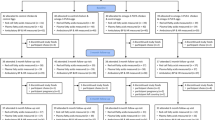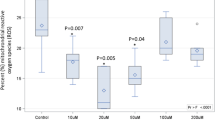Abstract
Objective: To study the possibility of increasing the very long-chain n-3 polyunsaturated fatty acids, eicosapentaenoic acid (EPA) and docosahexaenoic acid (DHA), in humans by means of consumption of a common food product, Scandinavian caviar paste, suitable for strategic enrichment with a high concentration of these fatty acids, and to measure the potential inducement of lipid peroxidation.
Design: A randomized double blind repeated measures experiment.
Subjects and interventions: In total, 16 healthy, nonsmoking subjects (eight men and eight women, age 42±12 y) were included in the study. Eight consumed 25 g ordinary caviar paste daily for 3 weeks, and eight the same amount of caviar paste enriched with a very stable fish oil (7%, wt/wt). Blood lipids, plasma phospholipid fatty acids and lipid peroxidation were measured.
Results: α-Linoleic acid was significantly decreased after intake of both ordinary (−8%, P<0.05) and fish oil caviar (−10%, P<0.05), as was the sum of all n-6 fatty acids (−6%, P<0.05 and −8%, P<0.001, respectively). The fatty acids EPA and DHA, as well as the sum of all n-3 fatty acids, increased significantly in both caviar groups but more in the group given fish oil caviar paste (EPA: +51%, P<0.05 and +100%, P<0.001, respectively; DHA: +24%, P<0.01 and +29%, P<0.001, respectively; sum of n-3:+27%, P<0.05 and +40%, P<0.001, respectively). Lipid peroxidation, measured as the thiobarbituric acid—malondialdehyde adduct, was increased by 26% (P<0.05) after intake of ordinary caviar paste, but was unchanged after intake of fish oil-enriched caviar paste.
Conclusions: Scandinavian caviar paste is a spread naturally enriched with n-3 polyunsaturated fatty acids that can be included in the diet to achieve an increase in these fatty acids. However, changing to caviar paste enriched with stable fish oil will lead to a considerably greater increase in EPA and DHA.
Sponsorship: Swedish Medical Research Council; Cardinova AB, Uppsala, Sweden.
This is a preview of subscription content, access via your institution
Access options
Subscribe to this journal
Receive 12 print issues and online access
$259.00 per year
only $21.58 per issue
Buy this article
- Purchase on Springer Link
- Instant access to full article PDF
Prices may be subject to local taxes which are calculated during checkout

Similar content being viewed by others
References
Bang HO & Dyerberg J (1980): Lipid metabolism and ischemic heart disease in Greenland Eskimos. In Advances in Nutrition Research, ed. HH Draper, pp 1–22. New York, USA: Plenum.
Boberg M, Vessby B & Croon L-B (1985): Fatty acid composition of platelets and of plasma lipid esters in relation to platelet function in patients with ischaemic heart disease. Atherosclerosis 58, 49–63.
Chirico S (1994): High-performance liquid chromatography-based thiobarbituric acid tests. Methods Enzymol. 233, 314–318.
Food Safety Authority of Ireland (2002): Investigation on PCDDs/PCDFs and several PCBs in fish liver oil capsules. Analysis and report provided by ERGO Forschungsgesellschaft mbH, Hamburg, Germany.
Frankel EN (1998): Lipid Oxidation. West Ferry, Dundee, Scotland: The Oily Press Ltd.
Haglund O, Luostarinen R, Wallin R, Wibell L & Saldeen T (1991): The effects of fish oil on triglycerides, cholesterol, fibrinogen and malondialdehyde in humans supplemented with vitamin E. J. Nutr. 121, 165–169.
Haglund O, Wallin R, Luostarinen R & Saldeen T (1990): Effect of a new fluid fish oil concentrate, ESKIMO-3, on triglycerides, cholesterol, fibrinogen and blood pressure. J. Intern. Med. 227, 347–353.
Higdon JV, Du SH, Lee YS, Wu, T & Wander RC (2001): Supplementation of postmenopausal women with fish oil does not increase overall oxidation of LDL ex vivo compared to dietary oils rich in oleate and linoleate. J. Lipid Res. 42, 407–418.
Higdon JV, Liu J, Du SH, Morrow JD, Ames BN & Wander RC (2000): Supplementation of postmenopausal women with fish oil rich in eicosapentaenoic acid and docosahexaenoic acid is not associated with greater in vivo lipid peroxidation compared with oils rich in oleate and linoleate as assessed by plasma malondialdehyde and F(2)-isoprostanes. Am. J. Clin. Nutr. 72, 714–722.
Higgins S, Carroll YL, McCarthy SN, Corridan BM, Roche HM, Wallace JMW, O'Brian NM & Morrissey PA (2001): Susceptibility of LDL to oxidative modification in healthy volunteers supplemented with low doses of n-3 polyunsaturated fatty acids. Br. J. Nutr. 85, 23–31.
Jacobs MN & Johnston PA (1995): Organochlorine pesticides and PCB residues in pharmaceutical and industrial grade fish oil. Greenpeace Research Laboratories, Technical note 05/95 (Fish oil 1-17).
Johansen O, Brekke M, Seljeflot I, Adelnoor M & Arnesen H (1999): N-3 fatty acids do not prevent restenosis after coronary angioplasty: results from the CART study. Coronary Angioplasty Restenosis Trial. J. Am. Coll. Cardiol. 33, 1619–1626.
Kris-Etherton PM, Shaffer Taylor D, Yu-Poth S, Huth P, Moriarty K, Fishell V, Hargrove RL, Zhao G & Etherton TD (2000): Polyunsaturated fatty acids in the food chain in the United States. Am. J. Clin. Nutr. 71, 179S–188S.
Liu M, Wallin R & Saldeen T (2001): Effect of bread containing fish oil on plasma phospholipid fatty acids, triglycerides, HDL cholesterol and malondialdehyde in subjects with hyperlipidemia. Nutr. Res. 21, 1403–1410.
Mantzioris E, Cleland LG, Gibson RA, Neumann MA, Demasi M & James MJ (2000): Biochemical effects of a diet containing foods enriched with n-3 fatty acids. Am. J. Clin. Nutr. 72, 42–48.
Mantzioris E, James MJ, Gibson RA & Cleland LG (1994): Dietary substitution with an α-linolenic acid-rich vegetable oil increases eicosapentaenoic acid concentrations in tissues. Am. J. Clin. Nutr. 59, 1304–1309.
Meilgaard MC, Civille B & Carr T (1991): Sensory Evaulation Techniques, 2nd Edition. Boca Raton, FL, USA: CRC Press Inc.
National Food Administration (1998): Livsmedelstabell, Fettsyror. Uppsala, Sweden: Livsmedelsverkets repro.
Saldeen T, Engström K, Jokela R & Wallin R (1999): Importance of in vitro stability for in vivo effects of fish oils. In Natural Antioxidants and Anticarcinogens in Nutrition, Health and Disease, pp 326–330. Cambridge, UK: The Royal Society of Chemistry, Special Publication 240.
Saldeen T, Wallin R & Marklinder I (1998): Effects of a small dose of stable fish oil substituted for margarine in bread on plasma phospholipid fatty acids and serum triglycerides. Nutr. Res. 18, 1483–1492.
Sanders TAB (2000): Polyunsaturated fatty acids in the food chain in Europe. Am. J. Clin. Nutr. 71, 176S–178S.
Sanders TAB & Younger KM (1981): The effect of dietary supplements of ω-3 polyunsaturated fatty acids on the fatty acid composition of platelets and plasma choline phosphoglycerides. Br. J. Nutr. 45, 613–616.
Simopolous AP, Leaf A & Salem Jr, N (1999): Essentiality of and recommended dietary intakes for omega-6 and omega-3 fatty acids. Ann. Nutr. Metab. 43, 127–130.
Stalenhoef AF, de Graaf J, Wittekoek ME, Bredie SJ, Demacker PN & Kastelein JJ (2000): The effect of concentrated n-3 fatty acids versus gemfibrozil on plasma lipiproteins, low density lipoprotein heterogeneity and oxidizability in patients with hypertriglyceridemia. Atherosclerosis 153, 129–138.
Tocher DR & Dick JR (2001): Effects of essential fatty acid deficiency and supplementation with docosahexaenoic acid (DHA;22:6n-3) on cellular fatty acid compositions and fatty acyl desaturation in a cell culture model. Prostaglandins Leukot. Essent. Fatty Acids 64, 11–22.
Wong SHY, Knight JA, Hopfer SM, Zaharia O, Leach Jr, CN & Sunderman Jr, FW (1987): Lipoperoxides in plasma as measured by liquid-chromatographic separation of malondialdehyde–thiobarbituric acid adduct. Clin. Chem. 33, 214–220.
Young IS & Trimble ER (1991): Measurement of malondialdehyde in plasma by high performance liquid chromatography with fluorimetric detection. Ann. Clin. Biochem. 28, 504–508.
Acknowledgements
We are grateful to AB Boviks Konservfabrik, Lysekil, Sweden, for supplying the caviar paste, to Dr I Marklinder for helping to organize the consumer sensory test, and to the subjects for participating in the study.
Author information
Authors and Affiliations
Contributions
Guarantor: T Saldeen.
Contributors: RW organized the production and consumer sensory test and made the fatty acid analyses. KE made the rest of the analyses, statistical analyses and drafted the manuscript. TS provided advice during all stages of the study. All authors were involved in the design of the study, organizing of the dietary intervention, and KE and TS in editing the manuscript.
Corresponding author
Rights and permissions
About this article
Cite this article
Engström, K., Wallin, R. & Saldeen, T. Effects of Scandinavian caviar paste enriched with a stable fish oil on plasma phospholipid fatty acids and lipid peroxidation. Eur J Clin Nutr 57, 1052–1059 (2003). https://doi.org/10.1038/sj.ejcn.1601641
Published:
Issue Date:
DOI: https://doi.org/10.1038/sj.ejcn.1601641



